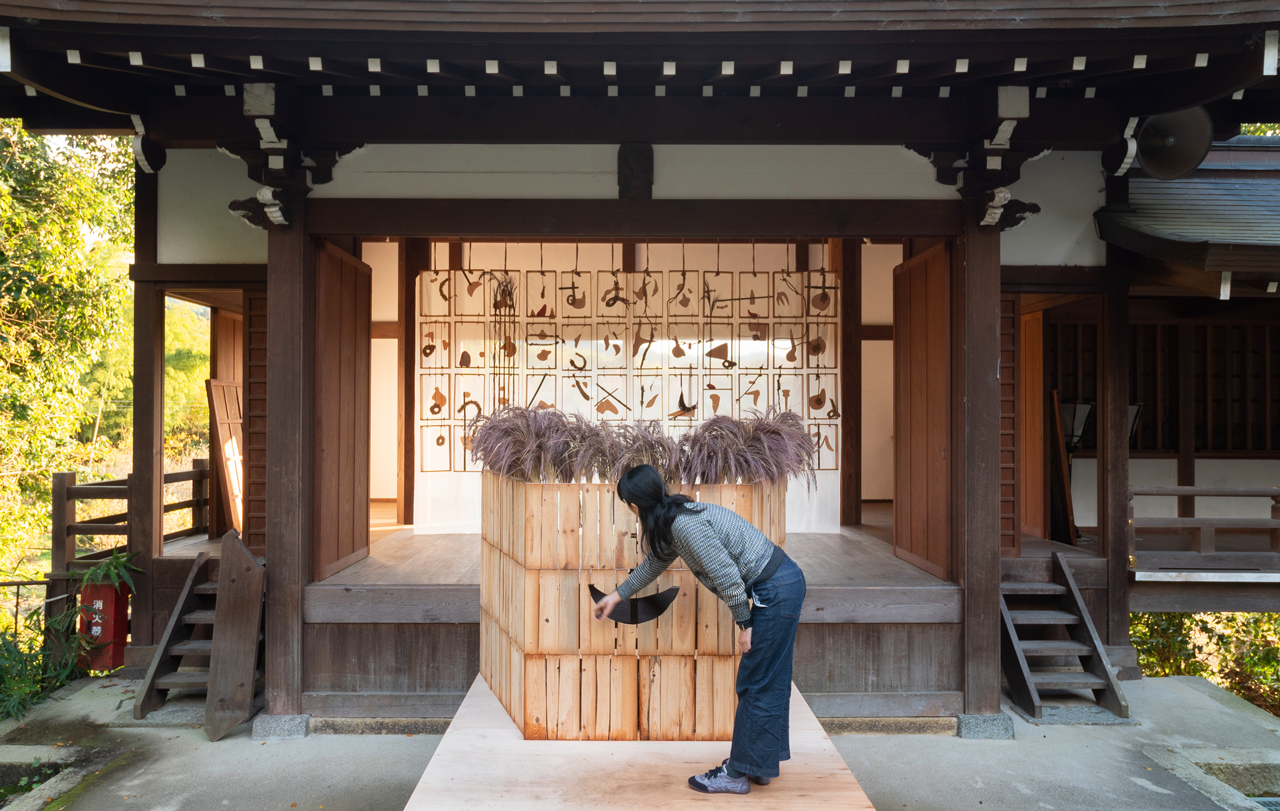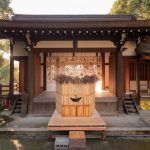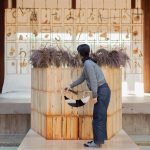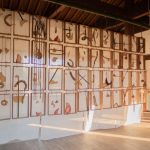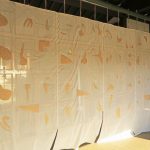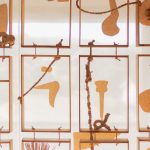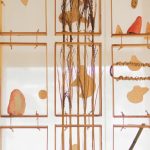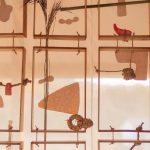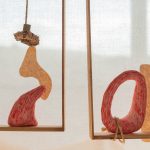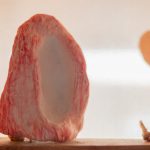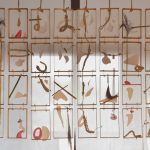Artist-in-Residence, Asuka Art Village, Nara, Japan.
Exhibition ‘round trip’ at Asuka-ni-imasu Shrine in Asuka.
奈良県明日香村飛鳥アートヴィレッジにて、滞在制作。
展覧会「回遊 round trip」飛鳥坐神社・神楽殿(明日香村)
Photo by ヤマダユウジ
‘A’ ‘Ka’ ‘Sa’ ‘Ta’ ‘Na ’Yu’ ‘Ha’ ‘Mu’ ‘Fu’ ‘Yo’ ‘To’ ‘Te’
–wood for strawberry boxes from Mr. Matsubara, ancient rice from Mr. Segawa, fan from Mr. Hanai, bamboo from the shrine, straw rope, hemp cord, rice bag, interfacing, clay, thread
This artwork consists of the “surrounding elements” related to tools and their environments.
When an old tool becomes obsolete and is discarded, its surrounding elements—such as the techniques used with the tool and the context in which it was employed—tend to disappear as well. This includes the skill required to customize the tool, its scale, and the sensory experience associated with its use.
During her stay in Asuka, Tsukuda visited several agricultural homes and observed the old tools used in their practices. Inspired by these observations, Tsukuda decided to incorporate the surrounding elements of these tools and materials into her artwork. For example, she included the standard dimensions of a box used for specific purposes, the way a person moves a fan, the fan’s movement to create airflow, and the friction of tying straw ropes.
Another significant surrounding element is the space of a shrine. A shrine is a place where people perform the motions of prayer—bowing twice, clapping twice, and bowing once. Although the results of prayer may not be immediately visible, the time spent at the shrine often has profound significance for the heart and mind, providing a space for reflection and connection. In her work, Tsukuda created a device that encourages viewers to engage in specific actions reminiscent of those performed in the shrine, which may or may not have a tangible effect, but at the very least, it provides a physical experience.
These various surrounding elements are now combined in the artwork through representations of Hiragana, a form of Japanese writing that captures the sounds of the language. The characters are arranged to form a poem written by Tsukuda about the hardships faced by agricultural workers. The shapes of the characters can be separated into pieces through the viewer’s movements or affected by the natural wind flowing through the shrine.
– – – – – – – –
「てとよふむはゆなたさかあ」
– 松原さんのいちご箱の材、瀬川さんの古代米、花井さんの扇風機、神社さんの竹・笹、
わら縄、麻ひも、米袋、接着芯、粘土、糸、森林組合さんに作っていただいた台
明日香村では、農業を営む方のお宅や蔵などを訪ね、古い農機具や今も使われる道具、またそれらに関連する日々のお話を伺う。ある道具が新しい素材や技術で更新されると、古い道具の多くは使われなくなる。同時に、その道具を作る木や竹や藁などの素材の特徴や、補修・改造をする技術、物の規格、扱うときの手や身体を動かす感覚など、道具それ自体と共に消えていくものがある。
神社という祈りの場所にも、一連の決まった形の道具や、祈りのための動作がある。祈りの道具や動作は、農業の作物を生み出すための道具や動作と、少し違うところに働く。そして、農業よりももう少しだけ変化しにくい。
これまで多くの人が、「あ」と「す」と「か」という音の並びを、この土地を言い表すために使用してきた。音を表す「かな」は、日常に溶け込む音を表す道具であり、かたちを変えながら今も使われる。
徐々に使われなくなる道具や素材・行われなくなる動作を用いて、今も使われる音のかたちを様々になぞる。それらを神社という祈りの動きの空間に組み込む。時計回りに参拝してから、最後に時計回りにハンドルを回してみる。
神社で祈るときと同様、何かは変わり、何かは変わらない。
